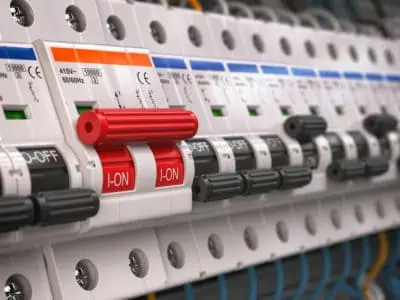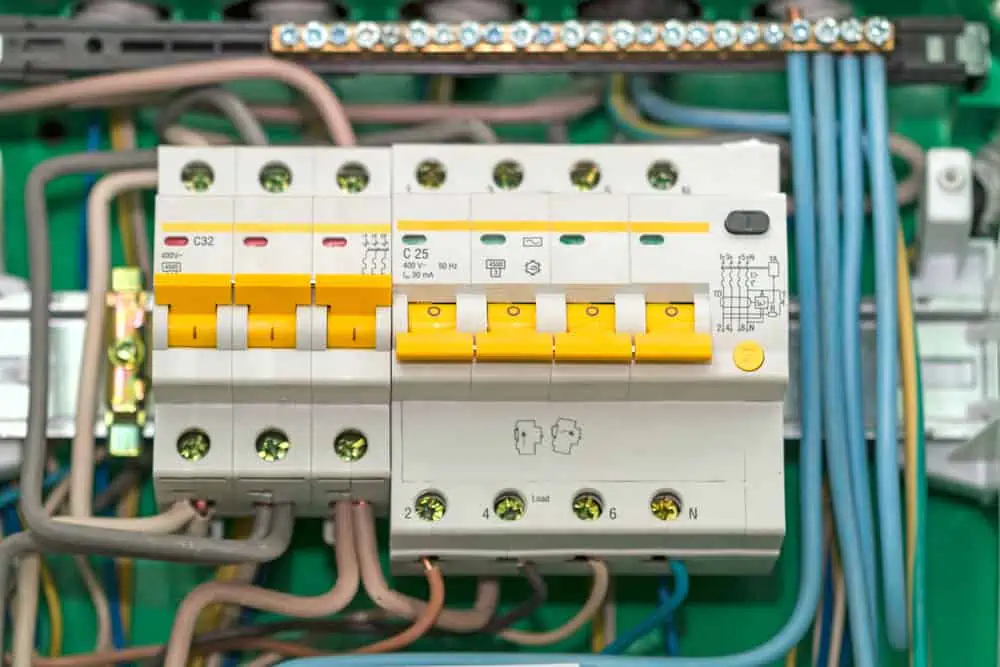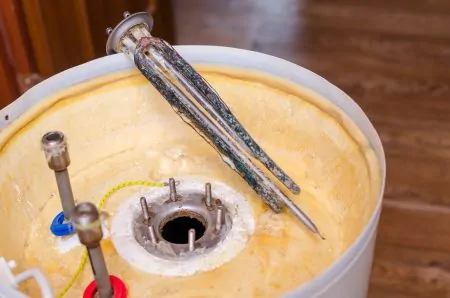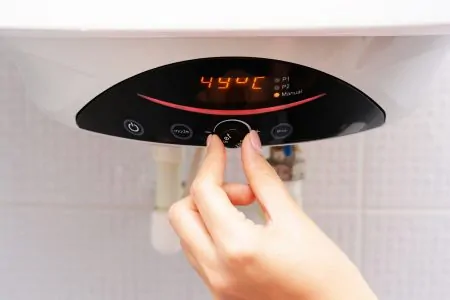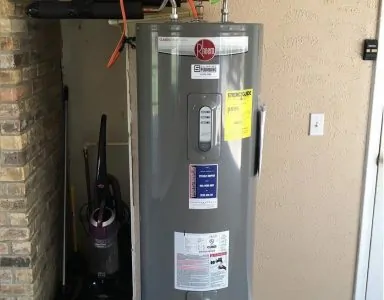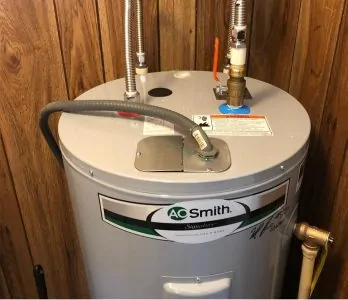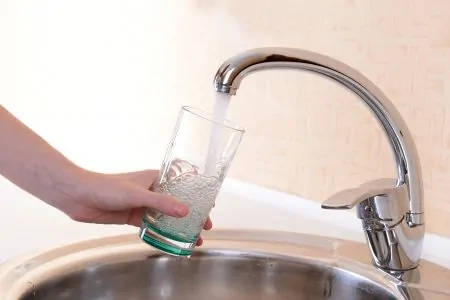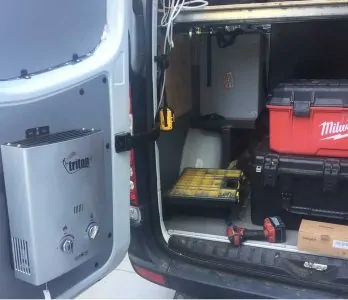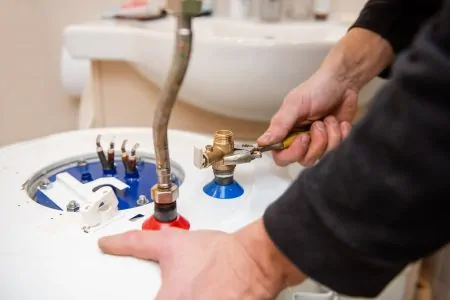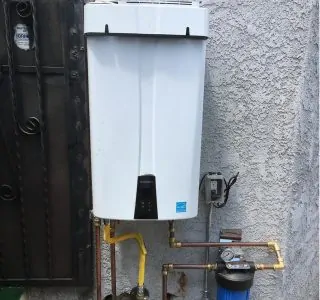Breakers are crucial for safety and protect you, your home, and your water heater. Knowing the water heater breaker size could be the difference between a tripped switch, an electrical fire, and a replacement heater.
We answer the question, “what size breaker is needed for a water heater,” and include an easy-to-follow breaker size chart.
Key Takeaways
- Water heater breaker size depends on power requirements and tank size.
- Most gas and electric water heaters need a 20 or 30 amp breaker.
- Follow the National Electrical Code (NEC) guidelines for proper breaker sizing.
- Always have a dedicated breaker for your water heater to ensure safety.
What Size Breaker for a Water Heater?
Understanding the power draw of your water heater is crucial. The hot water heater breaker size depends on the power requirements of the tank. Most water heaters use 220 to 240 volts of AC (alternating current).
Typically, you’ll need a 20 amp or 30 amp breaker for most gas and electric water heaters. If you undersize the breaker, it will trip the moment the heater switches on. Oversizing the breaker could result in element burn-out when there is a sudden power surge.
Most water heaters have 30, 40, or 50-liter tanks, so you need an element rated at the correct wattage to handle the size of the tank. The average residential water tank wattage is 3500 to 4500.
Tankless water heaters use less power, so you don’t need the same load capacity. Typically, they are rated at 120 volts and only require a 15-amp breaker. This is because they only heat the water you use, which takes a lot less effort than heating an entire tank.
Water Heater Breaker Size Chart
Your water heater size dictates the breaker size and thickness of the wire. Smaller water heaters need fewer breaker amps and the thinnest gauge wire. The reverse is true of the largest heaters.
With so many breaker variables, we thought it was helpful to put them into a handy chart.
| Element Wattage | 120 Volt Breaker | 220 Volt Breaker | Wire Gauge |
| 1500 | 15 amp | 15 amp | 14 |
| 2000 | 20 amp | 15 amp | 14 |
| 2500 | 30 amp | 15 amp | 14 |
| 3000 | 30 amp | 15 amp | 12 |
| 3500 | N/a | 20 amp | 12 |
| 4000 | N/a | 25 amp | 10 |
| 4500 | N/a | 30 amp | 10 |
| 5000 | N/a | 30 amp | 10 |
| 5500 | N/a | 40 amp | 8 |
How to Calculate Water Heater Breaker Size
The National Electrical Code (NEC) gives guidance covering breaker sizes and wire gauges for electrical safety. They stipulate that your circuit breaker load capacity should be 125 percent of the actual load. This allows for extra capacity during power surges and overloads.
This stipulation is sometimes called the 80/20 rule because you should always have 20 percent of your load capacity spare.
Safety Note
Electrical water heaters must have a dedicated 240V 30-amp circuit and 10-2 non-metallic cables. The breaker only powers the heater and no other appliances.
Now we need to do some old-school math to calculate the breaker size. Locate the thermostat panel and read the water heater’s voltage and wattage. Domestic water heaters are generally rated at 3500 or 4500 watts, and commercial units at 5500 watts.
4500 divided by 240V equals 18.75. 18.75 multiplied by the NEC load guidance of 125 percent equals 23.4375 amps. Next, round up the amps to 25, giving you the correct breaker size.
For commercial water heaters, the numbers look like this:
5500 divided by 240V equals 22.916. Multiply 22.916 by 125 percent, and we get 28.645. So, we need a 30-amp breaker for a commercial-grade water heater.
Water Heater Breaker Size Per Gallon
The capacity of your water tank makes a difference to the size breaker that you need: the larger the tank, the more powerful the heater. Let’s take a look at the breaker size per gallon.
30-Gallon
30-gallon tanks are among the smallest capacity and require less breaker load. You will need a 15-amp breaker for a 2500-watt heating element and a 20-amp for a 3500-watt element.
You can have a higher wattage-rated element in a smaller tank. It will heat the water faster, but you need to check the wire gauge to see if it can handle a higher load capacity without burning up.
The lower the number grade, the thicker the wire and the more capacity it can handle. So, eight-gauge wires carry the biggest load, while 14-gauge, the smallest.
40-Gallon
You will need a breaker that can cope with the load. Most 40-gallon water tanks have a 3500 or 4500-watt element. Choose between 20 and 30 amps to cover all eventualities.
50-Gallon
Fifty-gallon tanks have a larger capacity and need a breaker capable of tackling the job. This tank size is recommended for families of three or four people and requires a breaker between 25 and 30 amps.
What Size Breaker for a Gas Water Heater?
Tankless gas water heaters use less draw, so they don’t require a breaker with as much load capacity. They are heat-on-demand appliances and only need enough power to heat the water that you use. They are typically 120 volts and require a dedicated 15-amp breaker.
Why Is My Water Heater Tripping the Breaker?
There are three common ways that your breaker keeps on tripping: a burnt-out element, faulty wiring, or a broken thermostat.
Other reasons why your breaker trips include power surges and faulty breakers.
Burnt Out Element
Excessive loads cause the copper element to heat, which then triggers the breaker. The element burns out when it experiences a power surge. An easy way to check if you have a faulty element is to use a multimeter, like this AstroAI 2000.
Faulty Wiring
If your wiring is faulty, it might cause your breaker to trip. Inspect your wiring as part of your heater maintenance schedule to check for loose or broken wires. Black should connect to black, while the ground wire connects to the green screw on the tank.
Finally, the white wire connects to the red or white corresponding connector. Getting the wiring right is crucial because the black and white wires are classed as “hot” because they carry the load.
If you fail to ground the water tank, you could conduct an electrical charge through the pipes or even the water supply, which could be fatal.
Broken Thermostat
The thermostat tells your heating element to cut out when it reaches temperature. If the thermostat is faulty, the element keeps heating and eventually burns out. This causes the breaker to trip when the element burns out.
You may still operate on one thermostat, but it does mean one of your elements is unprotected or regulated.
Power Surge
There is nothing you can do about power surges. They occur occasionally, and when your breaker trips, it means it’s doing its job to protect the water heater.
Top Tip
If the breaker trips frequently, it could be a symptom of something more serious.
Faulty Breaker Switch
Faulty breakers may trip for no reason. If the breaker switch is old, it can wear out, but it could also be a wiring issue on the breaker board.
A poor connection, a broken wire, or loose wiring contribute to the breaker tripping.
FAQs
Final Thoughts
Knowing your hot water heater breaker size is crucial on so many levels. It keeps you safe, your water heater in working order, and prevents electrical fires. Sizing the breaker for the correct tank size is simple enough if you follow the NEC guidelines of 20/80.
You should only use 80 percent of capacity, keeping 20 percent spare for emergencies like power surges. Stick to that rule, and you can’t go wrong.
